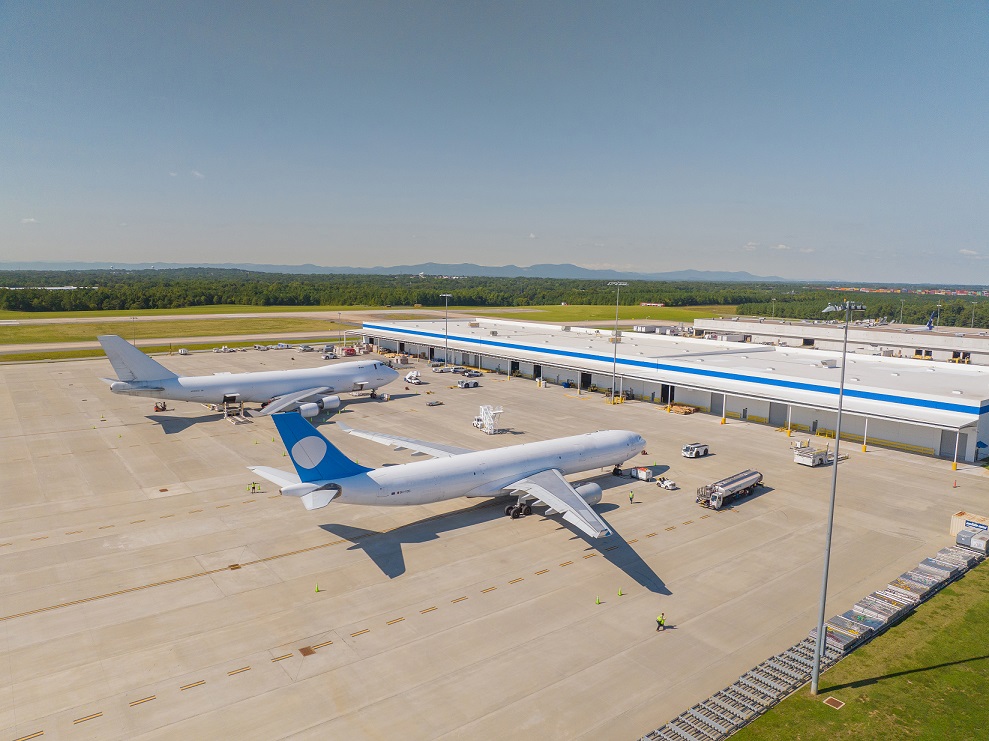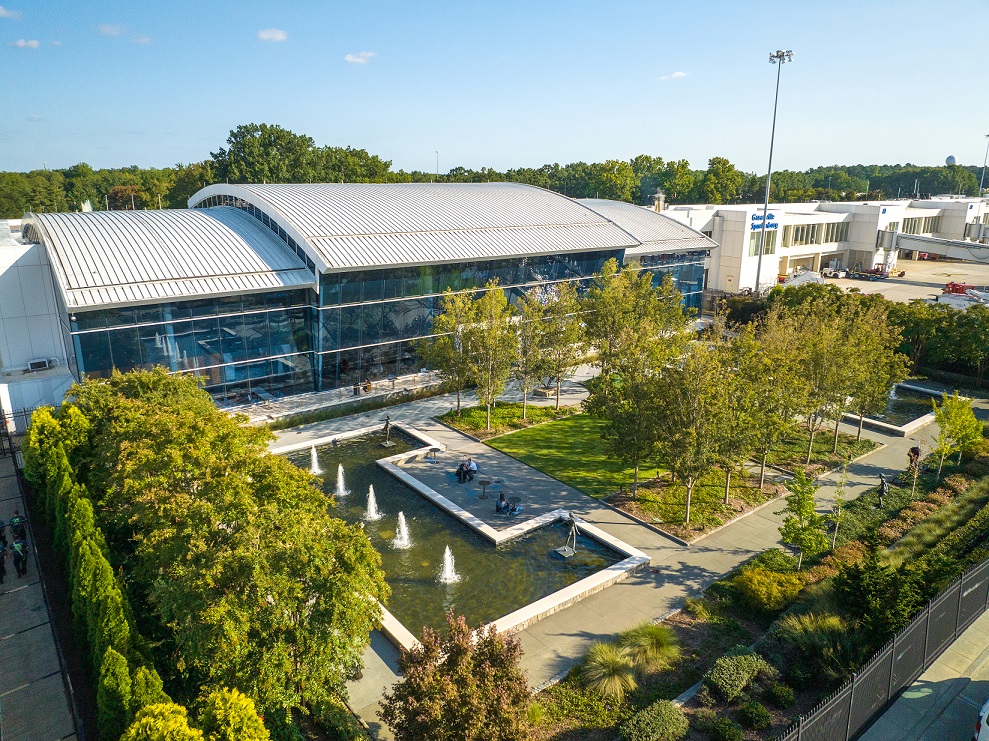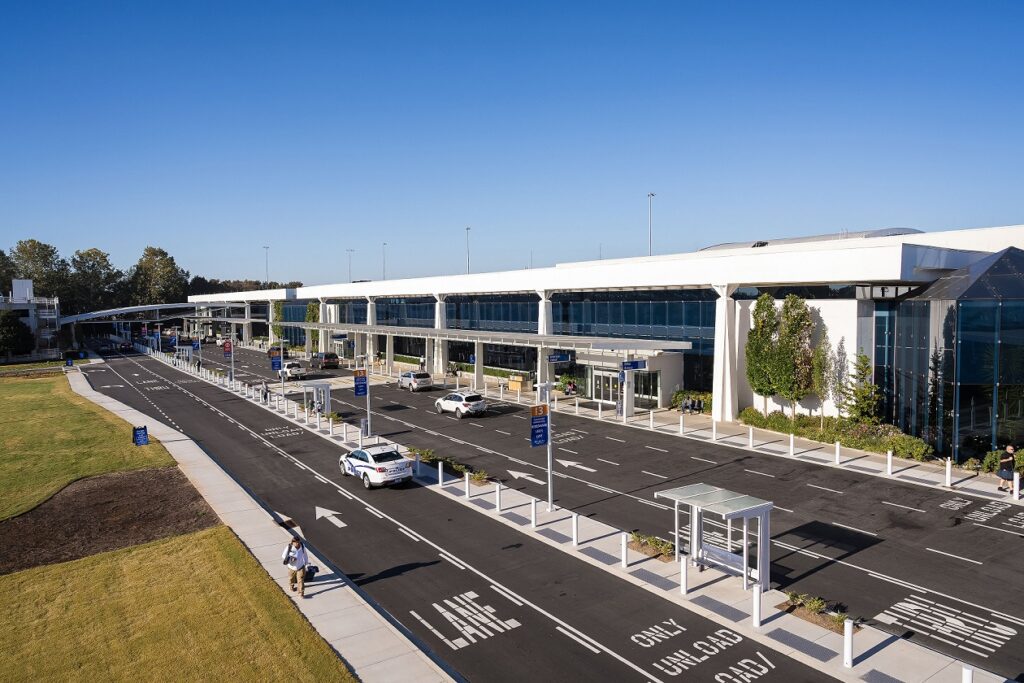Our History
Greenville-Spartanburg International Airport (GSP), Upstate South Carolina’s commercial service airport, was established in October 1962. At the time of its opening, the idea of regional collaboration was not a common one among cities, counties, politicians, businesses, or economic development organizations.
Without a major interstate roadway to connect the region, and few local television stations to share news, the cities of Greenville and Spartanburg and many small towns developed independently of one another. Agriculture and textiles were the driving force behind the region’s economy.

In fact, the land that is now home to Greenville-Spartanburg International Airport was once home to a farming community producing peaches, corn and cattle.
In the late 1950’s, significant change would impact the region, including the arrival of the jet age which introduced larger and faster commercial aircraft and the need for bigger airports to support them. Many 1920’s era airports like those in Greenville and Spartanburg, could not easily be modified to accommodate these new larger and faster aircraft.
By the early 1960’s, the nearby Charlotte airport was already receiving jet service, and the Atlanta airport was the busiest in the United States.As demand for passenger and cargo services increased, Upstate business leaders knew that bold action was needed to avoid being left behind. Among them was Charlie Daniel, founder of one of the largest construction firms in the country.
In 1957, Daniel approached his friend and frequent collaborator Roger Milliken with an ambitious proposal: build one large airport to serve the entire Upstate region. A textile magnate and CEO of what would become the largest privately held firm in South Carolina, Milliken had no background in aviation. Nevertheless, he accepted the lead role in the airport project “Immediately, because I respected Charlie Daniel, and he said this would be a monumental decision for the future.”

Milliken assembled a team of the top engineers and designers from around the country and led the effort to secure funding and government approval.
Greenville and Spartanburg County officials agreed to share the responsibilities and costs of the new airport equally, and a site located between the Upstate’s two largest cities and near the planned placement of Interstate 85 was chosen. After just 15 months of construction, the new airport opened on October 15, 1962.
The first flights to land at the new airport carried political and community leaders from both Greenville and Spartanburg Counties. During the ceremony, Roger Milliken announced “This airport is truly the gateway to this area. Through this gateway will pass the people who will make the future of this area. This airport will be a model of cooperation between Greenville & Spartanburg for others to point to.”
Through the ongoing support of travelers and the citizens of the region, GSP has grown into one of the most innovative, successful and well-regarded airports in the nation.

GSP Today
Today, GSP continues to be a shining example of what planning,innovation, and regional cooperation can accomplish.
Each year, the operations at GSP contribute an economic impact of over$4 billion, accounting for nearly 20,000 jobs in the region and directly generating over $1 billion in income for the Greenville-Spartanburg area. With nonstop passenger service to most top business and leisure destinations across the nation and flights provided by most major airlines, GSP enables over 2.8 million passengers to connect with the people and places that matter most to them.
For airports to achieve this level of service, it was important for GSP to plan for the future and welcome innovation. In 2012, airport leaders embarked upon a bold multi-year terminal renovation program called Wingspan. This $127 million enhancement program successfully positioned GSP to accommodate future growth while providing one of the most modern small airports in the nation.
With cutting edge technology, ample customer amenities and modern finishes, GSP now offers one of the most unique airport experiences in the nation. With service to the customer always top of mind, GSP routinely is recognized by its customers and the airport industry as a leader in customer service, convenience and innovation. In fact, the airport was named the Best Small Airport in North America by its customers in 2020, 2022 and 2023 and regularly receives industry awards for its concession program, facilities, landscaping, and use of technology.

In 2024, GSP served over 2.8 million passengers, surpassing the previous record of 2.6 million set in 2019. In addition, the airport set a new record for nonstop destinations served by announcing eleven new routes and one new airline in 2024.
The airport’s air side capabilities are equally impressive. The 11,001-foot runway can handle any size passenger or cargo aircraft operating in the U.S. today. This capacity allows GSP to also be a premier provider of services for general aviation, corporate aviation and air cargo customers.
Cerulean General Aviation, operated by the airport, provides fueling, hangar services, handling and logistics support for the private aviation needs of the region. Cerulean Commercial Aviation provides air cargo services, aircraft ground handling and warehouse services supporting the region’s supply chain and logistics companies. GSP regularly ranks among the top 25 cargo airports in the U.S. based on international trade value and offers the only non-stop scheduled international cargo service in the Carolinas. To support these flights and to accommodate future growth, Cerulean operates a 160,000-square-foot, 34-acre air cargo facility servicing customers and shipments from Belgium, China, Denmark, Germany and Mexico.
With over 3,000 acres of land, GSP plays a vital role in economic and real estate development in the region. GSP offers prime real estate and attractive growth opportunities for companies looking to locate their aviation, logistics or advanced manufacturing facilities in the region. In GSP’s International Logistics Park alone, there are nearly two million square feet of development under roof. The airport’s proximity to the Inland Port at Greer further stimulates prosperity in the area.

Our Future
Thanks to the support of the Upstate region and efforts to continue the vision of its founders, GSP remains positioned for growth in the future.
To meet the growing needs of the region, GSP adopted a 20-year Airport Master Plan in 2018 with nearly $1 billion of total planned infrastructure investment to help guide the airport into the next generation.
GSP’s bold future development plan took a major step forward in late 2023 with the launch of the Terminal Roadway Improvement Project (TRIP) which significantly improved the roadway system at GSP allowing for better flow of vehicle traffic and setting the stage for future phases of infrastructure improvements. In 2024, GSP began construction on the $97 million Garage C project. This facility will offer additional public parking capacity and space for the airport’s new consolidated rental car operations.
Also in 2024, GSP moved forward with improvements to the airport’s General Aviation Complex which included the construction of a new 25,000-square-foot corporate hangar, improved aircraft parking apron, and an expansion of the General Aviation terminal (FBO) which more than doubled its size. In 2028, a new air traffic control tower that will better serve the region’s future aviation needs will be constructed near the General Aviation Complex.

To further accommodate future growth, GSP expanded the TSA security checkpoint from four lanes to five, installed self-service check-in kiosks and added two additional jet bridges to the terminal growing available gates from 13 to 15.
In the future, plans call for the addition of a new on-site hotel, more corporate hangars, larger cargo facilities, the addition of up to seven aircraft gates, an expanded baggage claim, a dedicated federal inspection station (FIS) and other associated terminal improvements timed to meet the region’s growing population and need for air service.
Your GSP
Greenville-Spartanburg International Airport is fully committed to finding new ways to achieve our mission to advance the economic prosperity of the region by providing a safe, convenient, user-friendly and cost competitive air transportation system connecting the region with the nation and the world. With a focus on improving the passenger experience and embracing innovation, GSP will continue to serve as the region’s global transportation hub and economic catalyst by providing best-in-class infrastructure and service to residents of Upstate South Carolina.
















